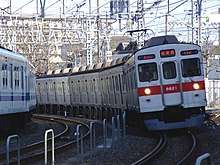Through train
A through train[1] (also through service,[2] run-through service/train[3]) is a concept of rail transport (commuter rail, subway systems, and mass transit) that involves a change in the operating provider of the line, or a change in the identity (usually operational) of the line, at a specified boundary, on a regularly specified schedule (not random). This is usually accomplished through compatible infrastructure—identical track gauge and durability issues (although variable gauge trains do exist, they tend to be expensive), rolling stock dimensions, curve speed and signaling compatibility, train station dimensions (to avoid damage to rolling stock), tunnels and bridge dimensions and maximum weight, and power requirements. The exact terminology (and definition) vary as usage; in the case of National Rail of the UK, a through train is one which may be used by a passenger to make their entire journey without changing trains.[1]
China
Chinese cities operate several through-train services (simplified Chinese: 直通运行; traditional Chinese: 直通運行; pinyin: zhítōng yùnxíng):
- Passenger: Some trains from China's Guangzhou-Shenzhen Railway cross the border and run onto the Hong Kong MTR East Rail to Hung Hom, but these trains do not stop along its stations, because border clearance is only done in Hung Hom. MTR also operate trains from Hung Hom onwards across the border on the Guangzhou-Shenzhen Railway.
- Freight-only: Chongqing-Duisburg, Germany; once a month.
Several subway systems have through operation between lines. Although this is usually a service crossing between a somewhat arbitrary boundary between two lines.
- Beijing Subway: Line 4 and Daxing line most trains from Line 4 through operates into the Daxing Line and all Daxing Line trains continue into Line 4.[4]
- Hong Kong MTR Light Rail: Vehicles of Route 614P and 615P continue to run onto each other's route after they arrive at the termini in Siu Hong and Tuen Mun Ferry Pier, effectively running on a loop line in both clockwise and counterclockwise directions.
- Hong Kong MTR: Trains on MTR's Kwun Tong Line may continue to run onto the southern half of Tsuen Wan Line to Central if services on the northern half of the latter are disrupted. This is also a standard special service during peak hours. Likewise trains on Kwun Tong Line may continue onto Tseung Kwan O Line to Po Lam or North Point when service on the latter line is disrupted.
- Nanjing Metro: some Line S1 trains through operate into Line S7.
- Zhengzhou Metro: Line 2 and Chengjiao line some trains from Line 2 through operates into the Chengjiao Line and vice versa.
- Guangzhou Metro: some trains of Line 3's Main Branch and Northern (Airport) Branch through operates. Normally, the Main branch operates trains from Panyu Square to Tianhe Coach Terminal stations, and the Northern (Airport) branch operates trains from Tiyu Xilu to Airport North stations. However, some trains will through operate, running between from Panyu Square to Airport North.
France
Paris Réseau express régional:
- RER A trains serving the Cergy and Poissy branches run on SNCF (western part) and RATP (eastern part) tracks.
- RER B runs on SNCF (northern part) and RATP (southern part) tracks.
In both cases, trains run contiguously, thus providing a one-seat ride across both SNCF and RATP networks. To achieve smooth network crossing, RATP and SNCF jointly designed and ordered specific MI 79 rolling stock (where MI stands for matériel d'interconnexion, French for "cross-network rolling stock.") Change of drivers was compulsory at network boundaries until 2008 when one-driver cross-network runs were introduced.
Germany
In Germany, such services are called Durchbindung.
Japan

Through services (直通運転, chokutsū unten) are regularly scheduled train services owned by an operator which runs over tracks which it does not own. Many urban railways in Japan operate such services to increase ridership, increase convenience and simplicity, and reduce time to destinations by eliminating transfers through seamless connection. One example is a Narita-to-Haneda service, which runs on four companies' tracks. Despite fewer new lines in recent years as the system is mature, more through services are proliferating to reduce cross metropolitan area connection time, at least in theory.
A 2016 MLIT study has shown that minor train delays are quite commonplace in Greater Tokyo during rush hour, at odds with Japan's image of train punctuality. The reason for this is that the subway lines in particular are subject to heavier loads, and thus more delay as riders rush in at the last minute, and forcing final door closings to be delayed. The proliferation of through-services has only magnified the problem, as it acts as a double-edged sword, though convenient in not having to switch trains, central Tokyo delays increasingly cause a ripple effect to through services on suburban lines.[5]
South Korea
Subway trains of Seoul Subway Line 1, Line 3 and Line 4 run through to Korail suburban lines.
Russia
Russia operates regular scheduled through services with other countries:
- Moscow-Beijing (via Trans-Siberian Railway and Trans-Manchurian Railway)
- Moscow-Sofia via Kiev
- Moscow-Nur-Sultan
- Moscow-Ulan Bator (via Trans-Siberian Railway and Trans-Mongolian Railway)
United States of America
Trains operating on the Metro-North Railroad in Westchester, New York run through to New York City tracks and switch from electric to diesel.
See also
- Trackage rights
- Express train
References
- http://www.nationalrail.co.uk/static/documents/content/NRCOC_old_2011.pdf
- http://www.jrtr.net/jrtr63/pdf/14-21_web.pdf
- http://www.necfuture.com/alternatives/
- "缓解客流压力,北京地铁4号线、大兴线调整运营措施-新华网". www.xinhuanet.com. Retrieved 2018-06-17.
- https://www.railway-technology.com/features/rush-hour-delays-tokyos-commuter-railways-feeling-strain/